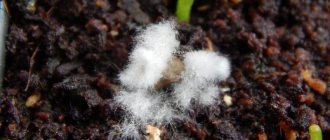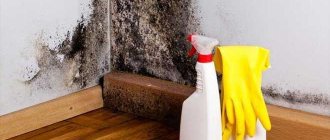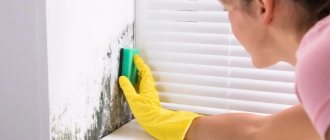If you find mold in any corner of your home, then this is certainly the first sign that you live in conditions with poor air exchange, you have problems with ventilation, or there are too many sources of moisture in your home. First you need to find out why excess moisture and mold may have appeared in your wardrobe with clothes. We will look at how to get rid of it and find the most common places where it accumulates in this article.
Important!
Remember, only after eliminating all sources of dampness and putting the ventilation system in order can you forget about this problem forever.
Causes of fungus and unpleasant odor
You will forget about the bad-smelling clothes and bedding stored in the closet only after the mold is completely eliminated. Unfortunately, there are many factors that can contribute to poor air quality in your home. Let's take as an example those that can be really dangerous:
- High air humidity in the room, respectively - in the closet,
- Storing wet clothes and bad-smelling items on shelves
- Storing clothes that have been poorly washed from perfumes and antiperspirants,
- The special chemical composition of things,
- The cabinet is made of non-standard elements.
It is also worth noting that the correct location of the cabinet is of great importance:
- It is better if it is located far from the bathroom and kitchen,
- It is not recommended to install it in a corner; it is preferable to choose a more ventilated place.
Important!
Place only fresh and completely dry clothes in the closet. Even freshly ironed, clean clothes need to dry a little before you hang them in your closet.
Prevention methods
If the furniture in the apartment is close to the walls, it is worth purchasing silica gel bags. This substance prevents dampness and mold formation. It is advisable to regularly check the back walls of furniture for the appearance of fungus.
Another mandatory measure is monthly ventilation of all cabinets and regular care of their contents:
- maintaining order there;
- wet dust wiping;
- getting rid of old things, especially those that emit a specific musty smell.
For winter clothes, it is worth selecting a separate area and in the summer it is necessary to ventilate and dry it - it is fur coats, hats, coats that often become damp and then often retain moisture for a long time.
The most unexpected places for mold to form
As you already understand, the ideal place for mold to exist and grow is the most humid and warm places in the house. Mold can form on clothes and bedding if you don't dry them enough.
Important!
By the way, the fungus can be not only gray, but also blue, green and even black. It spreads very quickly and can affect the entire surface.
In addition, in addition to color, there is always an odor, so as soon as you notice the unpleasant smell of dampness, you urgently need to figure out how to get rid of mold in the closet with clothes and bedding once and for all.
Criteria for the selection and use of funds
When choosing a means to destroy mold on clothes, you need to consider:
- Fabric type.
- The color of the item.
- Degree of infection.
- Processing method.
Cost also plays an important role.
Important! When choosing such products, be sure to familiarize yourself in detail with their composition, warnings and limitations, and instructions for use.
Mold does not like high temperatures and chemicals. Fabrics are also quite demanding in terms of methods and means of influencing them:
Linen and cotton clothes in white or pastel shades can be safely boiled with the addition of chlorine-containing chemical products.- Wool and synthetic fabrics react negatively to high temperatures, as this destroys their structure. Stain removers are used to clean them from mold.
- silk items from mold using turpentine or ammonia. Stain removers may harm delicate fabrics.
- Leather clothing is not afraid of mechanical stress, but is sensitive to chemicals, so it is better to remove mold from it with a stiff brush and soap solution.
- Bright items may lose their color when exposed to chemical reagents, so before use you should carefully study the rules for using the product and conduct a spot test of the fabric reaction on the wrong side of the clothing.
- Fabrics that are slightly contaminated with fungus can be saved by using regular laundry detergent, but stain removers and bleaches will have to deal with a harmful substance that is firmly ingrained into the structure of the material.
How to get rid of fungus?
If mold is discovered, it is necessary to take immediate measures to get rid of it, otherwise it will spread very quickly to all things, and then it will simply be impossible to do anything to restore the damaged things. If the fungus appears on the walls of the closet, then it has definitely settled in the clothes.
In this case, you must act as follows:
- All clothes and bedding must be placed on the balcony, hung in the sun, turned inside out.
- Then treat the cabinet with a special anti-mold compound,
- As soon as the items have dried a little in the sun, wash them with a special detergent
- Then dry them, iron them and put them back on the shelves.
Danger of mold to people
Learn more about why mold is harmful in an apartment or house. As it develops, it is capable of releasing thousands of spores that float in the air and can enter the lungs, bronchi, mucous membranes and skin. Mold affects human health in the following ways:
- She is the strongest allergen. When ingested, mold spores cause rhinitis, pharyngitis, pneumonia, bronchitis, and asthma.
- Human immunity, exposed to constant exposure to mold, slowly fades away.
- The fungus affects the skin, resulting in dermatitis and other inflammations.
- This is a poison that can cause poisoning, the development of cancer of the liver and lungs, and cardiovascular pathology.
- Affects the central nervous system.
According to the latest scientific data, mold fungi perceive the human body with a severely weakened immune system as a substrate, and in every possible way strive to master it, which leads to death.
How to remove the unpleasant smell of mold in the closet?
Now let’s take a closer look at how to get rid of mold in a closet with clothes and bedding, namely, the accompanying odor.
Important!
Once you have completely emptied the cabinet, examine its surfaces carefully because you must understand where the fungus is coming from and eliminate that source.
The mushroom may appear due to condensation from a battery or a wet cloth lying on the very last shelf. If this is the case, move the cabinet away from the radiator and throw away the wet item. Then leave the doors open and turn on the dehumidifier or fan so it blows air directly into the middle of the cabinet.
Then prepare a solution of warm water and vinegar in a one-to-one ratio and thoroughly treat all internal surfaces. Then rinse everything thoroughly with plain cold water and let the cabinet remain open for a few more days.
Important!
Only after you are sure that there is no moisture in the closet can you put the clothes back.
Another option for treating the inside of the cabinet is hydrogen peroxide. And to wipe the outside of the cabinet, you can use a solution with soda.
Sometimes it happens that an unpleasant odor does not disappear for a long time, even when there is no form of fungus present in the closet. In this case, you can make tampons from gauze soaked in vinegar and place them on the shelves of the closet.
Important!
If the smell of mold is coming from the floor, carpet or walls, you should try to clean and ventilate the room as often as possible to prevent mold growth.
Furniture processing
Carry out the treatment only after the closet is completely empty of clothes. Today, there are several simple methods that can at the same time kill harmful spores and save wood from further damage. Let’s look at the 2 most effective ones.
The most common method is to treat wood with soda solution. This method is suitable even for a cabinet with children's underwear, as it is safe. Dissolve 3 tbsp in a liter of water. l. soda, then wash the inside of the cabinet with the resulting solution, including all sides, shelves, walls and doors. Leave the cabinet open for 4 days. You can also use hydrogen peroxide. Treating children's cabinets with peroxide is as safe as using soda.
See also Disinfection of an apartment against mold
Another effective method is chlorine bleach. But keep in mind that this method of dealing with the problem is not suitable for everyone, since chlorine causes an allergic reaction in many people. The method is suitable for processing a closet where the clothes of adult family members are stored. Carrying out such treatment is unacceptable for disinfecting children's furniture.
First, you should remove all clothes from the closet and dry the inner surface using a special dryer or fan, and only then proceed directly to disinfection. It is better to take the wardrobe out of the room into the open air so as not to breathe in harmful fumes.
Mix equal parts water and chlorine bleach, put on gloves and use the resulting solution to wipe all the walls and shelves of the cabinet, inside and out. When done, wash the cabinet with clean water. It is advisable for the wardrobe to stand for about 3 days in the fresh air, which will help eliminate the unpleasant smell of chlorine.
When processing wardrobes using this method, you do not need to add additional detergents to the water so as not to harm your health. Using bleach allows you to completely clean the surface, which ordinary soda, which is best used at the initial stage of infection, cannot cope with.
How to protect clothes and bedding from mold?
We have already figured out what to do if mold is present in the closet with clothes. We will look further at how to get rid of it when it has penetrated deeply into the fabric of your favorite things. Naturally, no scented products will help here; you need to look for something more powerful. The fact is that fungal spores multiply very quickly and if they are not removed, they will continue to emit a terrible odor.
You can use the following tools to remove mold from clothing:
- Turpentine does an excellent job of eliminating the unpleasant “amber” when it comes to silk fabrics. You just need to soak a small piece of cotton wool in it and clean the affected area. Then thoroughly sprinkle the items with baby powder, cover with soft paper and iron on top. After this, of course, you need to wash the item. And to completely eliminate the fungus, you can add a few teaspoons of vinegar while rinsing.
- It is best to clean cotton items with chalk, namely, sprinkle crushed chalk on contaminated areas and iron with a napkin. After this, you need to wash things in the usual way, this way you will get rid of odors.
- Lemon juice is also great for this problem. You just need to soak your clothes in it, sprinkle salt on top of everything, and wait until the solution dries. Then wash the clothes with soap, then throw them in the washing machine on the usual cycle for the fabric.
- It is better to treat white clothes and white bedding with bleach or hydrogen peroxide. The main thing is to work very carefully so as not to accidentally damage the fabric.
- Colored fabrics can also be cleaned with alcohol or ammonia. Simply dilute alcohol with water in equal proportions and treat the areas where there is mold, and then wash the product.
- Toothpaste does a great job of removing the fresh smell of fungus. You should apply it to the stain and wait about fifteen minutes, and then rinse the item in warm water.
How to remove with chemicals?
If traditional methods do not cope with mold colonies, household chemicals become a panacea.
Chemical agents are produced in the form of:
- bleaches;
- washing powders;
- stain removers.
Bleaches
Bleach is widely used not only for its main purpose, but also to remove fungal stains on clothes.
They are divided into:
- Oxygen-containing (OXY, “BOS”, Oxygen).
- Chlorine-containing substances (“Belizna”, ACE, “Dichlor”).
These products are used strictly in accordance with the instructions indicated on the packaging.
Oxygen-containing bleaches have an antibacterial effect and work without prolonged soaking or boiling. Suitable for both white and colored clothing. They work best with synthetic fabrics.
Attention! On the packaging of products containing oxygen, there is a corresponding symbol : O₂ , Oxigen, Active .
Chlorine-containing bleaches effectively remove mold stains even in cold water, but with frequent use they have a negative effect on the structure of the fabric, leading to premature wear.
Used for white and dull linen and cotton fabrics. When machine washing, only oxygen bleaches are used!
Laundry powders
You can successfully treat mold islands that have recently formed on clothes using laundry detergents:
- the dose of powder specified in the instructions is added to hot water;
- clothes are dipped into the solution and left for a couple of hours;
- then wash and rinse intensively.
Users highly appreciated the quality of such washing powders as:
- Ariel;
- Bimax;
- Tide.
Stain removers
Stain removers easily deal with fungus on fabric. When purchasing, you should pay attention to what material this product is intended for.
Well proven:
- Dr. Beckmann;
- "Expert";
- "Antipyatin."
Procedure:
- apply to fabric;
- withstand a certain time;
- wash.
Popular means
The top three in terms of popularity of use are:
- "White";
- Domestos;
- Vanish.
"White"
The chemical industry product “Belizna” successfully cleans large volumes of fabric affected by old fungus.
To do this, pour one tablespoon of this product into a glass of hot water and generously moisten the contaminated surfaces of the clothing.
Twenty minutes is enough for visible results. If the mold is difficult to remove, keeping it in a solution of “Belizna” at a high concentration is extended to a day.
To achieve the “sterility” effect, boiling can be used, taking into account the characteristics of the fabric.
The active component of “Whiteness” is a strong oxidizing agent, which provides excellent disinfectant and bleaching properties.
The undeniable advantages of this tool are:
- Efficiency.
- Multifunctionality.
- Affordable price (from 20 rubles per 1 liter).
There are also disadvantages:
- May cause allergic reactions in the body when used.
- It has a sharp odor that irritates the receptors.
"Domestos"
Domestos is a multifunctional product, great for cleaning and disinfecting the entire home. In addition, it can be used to expel fungus from natural materials (linen, cotton).
The procedure is as follows:
- Dissolve two measuring caps of the product in three liters of water at room temperature;
- put clothes there;
- stand for 10 minutes;
- rinse thoroughly;
- machine wash.
The advantages of Domestos include:
- cost-effectiveness;
- speed;
- wide range of uses.
The disadvantages are:
- Toxicity.
- Specific smell.
- Aggressive reactions to colored fabrics, stickers on clothes, appliqués.
The average cost of the product is 170 rubles per 1 liter.
"Vanish"
Vanish's powerful oxygen stain remover can be safely used to remove mildew from colored clothing made from fine, delicate fabrics such as wool and silk.
Mode of application:
- Apply stain remover to the area of clothing infected with fungus.
- Lightly rub the stain and leave for a few minutes, visually monitoring the process.
- Wash and dry the item well.
List of advantages of Vanish:
- Does not contain chlorine.
- Affects mold without causing changes in the structure and color of the fabric.
- Has a pleasant smell.
Flaws:
- It cleans well only recently contaminated areas; old mold stains will have to be subjected to several treatments.
- The liquid version of the stain remover has a short shelf life; the effectiveness of the product decreases over time.
- The expected advertising effect does not always correspond to the actual one.
The price range of Vanish stain removers starts from 400 rubles per 1 liter.











